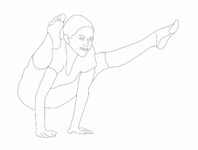The meaning of gas release pose
- The gas release pose is also known as Pawanmuktasana.
- Pawanmuktasana is a Sanskrit word.
- It is pronounced as ‘PUH-vuhn-mukt-AAHS-uh-nuh’.
- Pawan means ‘wind’, mukta means ‘release’ and asana means ‘yoga pose’
- Pawanmuktasana means ‘wind releasing pose.’
What is a Pawanmuktasana-gas releasing pose?
- The gas-releasing pose is one of the essential passive yoga poses.
- It is called Pawanmuktasana because of its entrapped gas-releasing tendency from the stomach and intestine.
- It works well on the stomach, intestine, and abdominal organs and plays a vital role in releasing entrapped gases from the body.
- The pose helps prevent and manage diabetes, burning off belly fat, lung & heart-related disorders, etc.

Gas-releasing pose introduction
The author has decades of experience in yoga training and therapy. Thousands of yoga students and practitioners have benefited from our yoga training classes. From my experience, you will get here to know what a is, how to do it, and its benefits and precautions. The easily explained steps, uses, precautions, images, and simple and easy-to-understand videos of gas-releasing poses will help you realise the yoga pose is technically correct, thereby extracting maximum benefits.
How to do gas release pose step by step.
Pawanmuktasana is a simple and easy yoga pose. Its more straightforward step-by-step technique has been mentioned below.
- Lie flat on your back.
- Inhale and raise your legs to 90 degrees.
- Bend your legs at the knees and bring them towards the chest.
- Clasp your knees by interlocking your fingers and putting pressure on your abdomen and chest.
- Exhale, raise your head; try to touch your forehead with your knees.
- Maintain the pose with slow inhaling-exhaling.
- Bring your head down slowly, followed by your legs.
- This is the one round.
- Do 2 to 3 rounds at your convenience.
- Initially, one can also do Supt Pawanmuktasana

Supt Pawanmuktasana
Breathing Awareness and Duration
To harness the maximum benefits of Pawanmuktasana, the knowledge of breathing awareness and mechanisms has greater importance. One should try to feel the body movement and synchronisation of breath by closing one’s eyes. Inhale while raising your legs. Exhale while bending your legs and bring it towards your chest and forehead. Slow and deep inhaling-exhaling should be maintained while holding the pose. Initially, one has to keep it for 30 seconds. However, the duration may be increased as per one’s flexibility, stamina, and comfort.
Muscular movement
The yoga pose facilitates excellent massaging and stretching to the abdominal region and the organs. During the gas-releasing pose, various muscles experience stretching and compressing, viz., abdomen, back, neck and arms. The abdominal muscles and nerves are more involved in the movement.
Gas-releasing pose in different schools of yoga
Pawanmuktasana has some variations in steps and technique while performed by renowned yoga experts and teachers. These different techniques by different schools of yoga while practising Pawanmuktasana are given below.
- Iyengar yoga: The technique is followed as mentioned above in the Iyengar school of yoga.
- Vinyasa yoga: The head is not raised, and the knees put more pressure on the chest and abdomen.
- Ashtanga yoga: It is similar to the technique mentioned above.
- Baba Ramdev yoga: It is similar to the technique mentioned above.
- Art of living: It is similar to Ashtanga yoga.
- Power yoga: The main focus is given to stretching and rigour of the posture.
- Hot yoga: It is similar to power yoga but more strenuous.
- Satyananda yoga: It is similar to Ashtanga yoga.
- Bikram yoga: It is similar to the technique mentioned above in the article.
Top 10 health benefits of gas releasing pose
Some of the essential benefits of Pawanmuktasana are given below
- Abdominal organs: Practicing the yoga pose gives excellent massage to the abdominal organs, increasing blood circulation to the various organelles, thus enhancing their efficiency.
- Entrapped gas removal: The stretching, compressing, and tensing of abdominal muscles ensure to flush out the trapped gases, harmful substances, and toxins from the body. Accordingly, it improves the function of the various systems of the body.
- Flat stomach: The pose effectively burns extra fats in the abdomen. For this, adequate pressure should be exerted on the abdomen through the bent legs and maintain the posture as long as possible. It also helps to reduce fats from various parts of the body.
- Impotence: It puts adequate pressure on the reproductive organs, thus beneficial in case of sterility and impotence.
- Strengthens back muscles: The yoga pose strengthens the back muscles and spinal nerves.
- Constipation: It makes digestion smooth and pleasing to overcome constipation.
- Healthy heart: It is also suitable for preventing and managing cardiac problems and lungs.
- Sexual disorders: The pose gives adequate massage to the hips and the region around the reproductive organs, thus easing the issues during the menstrual cycle.
- Better blood circulation: It ensures better blood circulation to the entire body because of its stretching and compressing nature.
- Gastric juices: Since the pose plays an essential role in massaging the abdominal organs, it ensures proper secretion of gastric juices.
Gas release poses contraindications
Some of the few precautions/limitations of Pawanmuktasana are:
- Pregnancy
- Peptic ulcer
- Fracture ribs
- Abdominal surgery
- Headache and migraine
- Sever back pain
- Shoulder and elbow injury
- Neck strain
- Piles
- Hyperacidity
- High blood pressure
Beginner’s tip
Practising Pawanmuktasana properly is a more complex task. In the beginning stage, could you pose only with one leg, Sputa Pawanmuktasana? After having mastery over it, try with both legs. One can also perform the pose without raising the head.
Gas release pose sequence
Preparatory pose
- Tadasana
- Stickasana
- Supta pawanmuktasana
- Boat pose
- Ardha Halasana
Follow-up / counterpose
- Setu Bandhasana
- Bhujangasana
- Shlabhasana
- Chakrasana
Top 6 facts of gas releasing pose
Here, we will mention the points to be remembered, tips, and mistakes to avoid while doing the yoga pose.
- To harness maximum benefits, try to touch the knees with your forehead.
- First performed through the right leg, followed by the left.
- Initially, it should perform for 20-30 seconds. Gradually, it increases the duration as per one’s flexibility and capacity.
- It gives adequate stretch to the abdomen, lower back, neck, arms, thighs, and buttocks.
- It strengthens the back, digestive system, and reproductive organs.
- The mouth should be closed.
The science behind gas-releasing pose
There is a systematic procedure for performing the gas-releasing pose. There is a science behind it. After this, the waste matter proceeds to the large intestine (colon). The large intestine is about five feet in length and rises upwards on the right side of the body (ascending colon), crosses horizontally in the region of the navel (transverse colon), and then goes downwards on the left side of the body (descending colon). It terminates in the anus. For this reason, Pawanmuktasana must be first performed with the right leg bent so that waste matter is encouraged to pass in the proper direction and more quickly to the anus for expulsion from the ascending colon to the descending colon.
Video of gas-releasing pose
- The video of Pawanmuktasana has been made very simple and easy to help understand the practitioners.
- It has been developed after a discussion with many yoga experts and teachers.
- Extensive research has also been carried out while making the video.
Video courtesy: Morarji Desai National Institute of Yoga
Modification and variations
- Supt Pawanmuktasana
- Pawanmuktasana
- Easy Pawanmuktasana: Knees are bent and pressing the chest and abdomen






